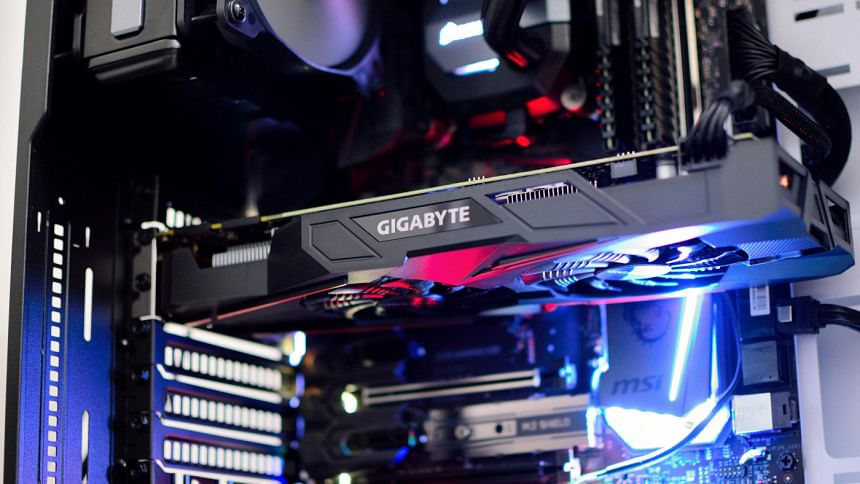Demystifying graphics cards: A beginner's buying guide

Any gamer who wishes to enjoy competitive or AAA games is subject to making a decision - to choose either a gaming PC or a Current Generation Console. We can argue forever about which medium of enjoying games is more fulfilling, but we all know the best way to enjoy games is on your smartphone. Jokes aside, if you are considering a gaming PC then you should know that Graphics cards are the beating heart of any computer tasked with gaming. In layman's terms, they are components that go inside your computer enabling your machine to handle intensive 3D tasks.
There exist some CPU-bound games which end up taxing the CPU more than the GPU but those are outliers and should not represent the average gaming scenario. As DirectX12 & VULKAN work their way toward reducing CPU load, the future of computational performance might depend more upon GPUs than anything.
Experience has shown that in a relatively modern system, the GPU is more often than not the part to upgrade if one wishes to attain more FPS (Frames Per Second).
Technologies at play
First of all, it is important to be informed that current-generation gaming is not as reliant upon rasterization (Raw Power) as the games during the PS4 era were. Rasterization is a traditional method of rendering 3D models & landscapes and is reliant upon brute horsepower. Nowadays, Game developers take freedom in employing various types of technologies in their games to add extra visual flair.
If one has not been living under a rock, then it can be observed that current-generation games have taken a leap in terms of fidelity & scale. This increase in scale paired with ray tracing cannot always be tackled with raw power, hence utilizing upscaling technologies like DLSS/FSR enables these games to stay pretty and run fast without losing much eye candy.
Each GPU manufacturer has a different way of implementing these technologies, and it plays an important role in the consumer's buying decision. For a more fair assessment, we will avoid talking about Intel GPUs as we await their promising technology & hardware to age
NVIDIA & DLSS (Deep Learning Super Sampling)
Nvidia is a technology giant that invests heavily in AI. This enables them to bring technologies like Raytracing & Advanced Upscaling in games ahead of the pack. It is generally known that Nvidia cards are overpriced compared to their similarly performing AMD counterparts. On top of that, Nvidia is infamous for providing substantially less VRAM for the price. One might think that these two reasons are enough to sway away from Nvidia, but the reality is quite different from that. Nvidia cards, despite their overpriced status, are the most reliable way to run PC games on your computer. But it comes at a cost and the cost can sometimes not be justified at all, especially since you can get a similarly performing AMD card for much less. So why are people opting for bank-breaking Nvidia? The answer is simple - DLSS.
DLSS is a revolutionary breakthrough in AI graphics that multiplies performance and sustains near-identical visual fidelity. Almost all games have it implemented natively. The problem with upscaling technologies like FSR 1.0 & FSR 2.2 is that even though they are impressive technologies that are brand agnostic, they still leave evidence of obvious downscaling.
DLSS, on the other hand, produces an image that is nearly identical to the Native image. Sometimes the image produced by DLSS is better than native if the anti-aliasing solution in the game is not done properly. This paired with better Raytracing performance thanks to its Tensor AI cores, makes Nvidia cards stand out. However, as mentioned above, sometimes the cost cannot be justified and that is when we look at the competition.
AMD & FSR (FidelityFX Super Resolution)
AMD's hardware-agnostic solution of upscaling is more popular than DLSS. Console games rely heavily upon checkerboard & AMD's FSR to produce a non-native 4K image. Ever wonder how the PS5 with barely enough horsepower as a midrange GPU, manages to run Cyberpunk2077 with ease? Well, open-source upscaling technologies like AMD's FSR are your answer. Even though it fulfills the task of providing an increase in framerate well, it does so at the cost of some visual fidelity.
AMD is very generous about providing VRAM to its cards and it shows. Mid-range AMD cards possess 16 Gigabytes of VRAM whereas similarly performing Nvidia cards (which also cost more, mind you) have only 8 Gigabytes. Now, more VRAM does not at all mean that you will get more performance, but it is something to take note of.
Buying Suggestions
The choice between Nvidia and AMD often comes down to specific needs and budget constraints. For those on a tight budget of below 20K, options like the Peladn GeForce GTX 1660 Ti 6GB (GDDR6) and PELADN RX 5600 6GB (GDDR6) present themselves. Although the AMD RX5600 slightly outpaces the Nvidia 1660TI in speed, it lacks support for mesh shaders. The brand PELADN is highlighted for its reliability amidst a market segment rife with underperforming options. However, the advice leans towards bypassing this tier altogether, recommending a savings of an additional 10K for a leap into the next performance category. For those considering these budget-friendly choices, RyansComputers for Nvidia and Ultra Technologies for AMD are recommended retailers for the lesser-known but cost-effective PELADN brand.
Moving up to the low-mid end spectrum, with a budget ceiling of 30K, the competition narrows down to the OCPC GeForce RTX 2060 Super 8GB (GDDR6) and the Sapphire Pulse AMD Radeon RX 6600 8GB (GDDR6). The RX 6600 edges out the 2060 Super in terms of power but falls short of the Nvidia card's feature set. Notably, the RTX 3050 is deliberately omitted from recommendations, criticized for its existence in the market. Creatus Computers is the go-to for the OCPC 2060 Super, offering a balance of cost-effectiveness against its more expensive counterparts.
In the mid-range category, under a 40K budget, the RTX 3060 12GB (GDDR6) and RX 7600 8GB (GDDR6) vie for attention. The RX 7600 not only surpasses the RTX 3060 in performance but also comes at a lower price point. However, it sacrifices Nvidia's broader feature set and some VRAM, making the choice between them one of preference and priority.
For those with a higher budget of below 65K, targeting the upper mid-range, the RTX 4060Ti 16GB (GDDR6) and RX 7700XT 12GB (GDDR6) are closely matched contenders for 1440P gaming. This tier offers a balance of price to performance, suitable for gamers seeking high fidelity without venturing into the top-tier budget.
Finally, at the high end, with budgets extending below 130K, the RTX 4070Ti 12GB (GDDR6X) and RX 7900XTX 24GB (GDDR6) stand out. The 7900XTX from AMD not only outperforms the 4070Ti but also competes with Nvidia's 4080 in certain aspects, all while being more affordable. This segment caters to those demanding the utmost in gaming performance, where AMD's offering presents a compelling value proposition against its Nvidia counterpart.

 For all latest news, follow The Daily Star's Google News channel.
For all latest news, follow The Daily Star's Google News channel. 



Comments